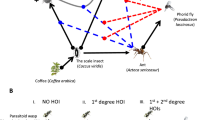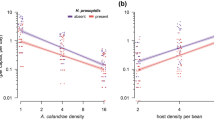Abstract
In this study, we used data from both experiments and mathematical simulations to analyze the consequences of the interacting effects of intraguild predation (IGP), cannibalism and parasitism occurring in isolation and simultaneously in trophic interactions involving two blowfly species under shared parasitism. We conducted experiments to determine the short-term response of two blowfly species to these interactions with respect to their persistence. A mathematical model was employed to extend the results obtained from these experiments to the long-term consequences of these interactions for the persistence of the blowfly species. Our experimental results revealed that IGP attenuated the strength of the effects of cannibalism and parasitism between blowfly host species, increasing the probability of persistence of both populations. The simulations obtained from the mathematical model indicated that IGP is a key interaction for the long-term dynamics of this system. The presence of different species interacting in a tri-trophic system relaxed the severity of the effects of a particular interaction between two species, changing species abundances and promoting persistence through time. This pattern was related to indirect interactions with a third species, the parasitoid species included in this study.









Similar content being viewed by others
References
Abrams PA, Chen X (2002) The effect of competition between prey species on the evolution of their vulnerabilities to a shared predator. Evol Ecol Res 4:897–909
Carvalho LML, Thyssen PJ, Goof ML, Linhares AX (2004) Observations on the succession patterns of necrophagous insects on a pig carcass in an urban area of southeastern Brazil. Anil Aggrawal’s Internet J Forensic Med Toxicol 5:33–39
Chaneton EJ, Bonsall MB (2000) Enemy-mediated apparent competition: empirical patterns and the evidence. Oikos 88:380–394
Faraway JJ (2006) Extending the linear model with R: generalized linear mixed effects and nonparametric regression models. Chapman and Hall/CRC, Broken Sound Parkway NW
Faria LDB, Orsi L, Trinca LA, Godoy WAC (1999) Larval predation by Chrysomya albiceps on Cochliomyia macellaria, Chrysomya megacephala and Chrysomya putoria. Entomol Exp Appl 90:149–155
Faria LDB, Godoy WAC, Reis SF (2004) Larval predation on different instars in blowfly populations. Braz Arch Biol Techn 47:887–894
Faria LDB, Reigada C, Trinca LA, Godoy WAC (2007) Foraging behavior by an intraguild IG-predator blowfly, Chrysomya albiceps (Diptera: Calliphoridae). J Ethol 25:287–294
Godfray HCJ (1994) Parasitoids: behavioral and evolutionary ecology. Princeton University Press, New Jersey
Godoy WAC, Zuben CJV, Reis SF (1996) Theoretical estimates of consumable food and probability of acquiring food in larvae of Chrysomya putoria (Diptera: Calliphoridae). Mem Inst Oswaldo Cruz 91:257–264
Godoy WAC, Von Zuben FJ, Von Zuben CJ, Reis SF (2001) Spatial-temporal dynamics and transition from asymptotic to bounded oscillations in Chrysomya albiceps (Diptera: Calliphoridae). Mem Inst Oswaldo Cruz 96:627–634
Goodbrod JR, Goff ML (1990) Effects of larval population density on rates of development and interactions between two species of Chrysomya (Diptera: Calliphoridae) in laboratory culture. J Med Entomol 27:338–343
Grassberger M, Frank C (2004) Initial study of arthropod succession on pig carrion in a central European urban habitat. J Med Entomol 41:511–523
Grillenberger BK, Zande LVZ, Bijlsma R, Gadau J, Beukeboom LW (2009) Reproductive strategies under multiparasitism in natural populations of the parasitoid wasp Nasonia (Hymenoptera). J Evol Biol 22:460–470
Gurney W, Blythe S, Nisbet RM (1980) Nicholson’s blowflies revisited. Nature 287:17–21
Holt RD (1977) Predation, apparent competition and the structure of IG-prey communities. Theor Popul Biol 12:197–229
Holyoak M, Sachdev S (1998) Omnivory and the stability of simple food webs. Oecologia 117:413–419
Kondoh M (2008) Building trophic modules into a persistent food web. PNAS 105:166631–166635
McCann SK, Hastings A, Huxel GR (1998) Weak trophic interactions and the balance of nature. Nature 395:794–798
Morin PJ (1995) Functional redundancy, non-additive interactions, and supply-side dynamics in experimental pond communities. Ecology 76:133–149
Nagel WP, Pimentel D (1964) The intrinsic rate of natural increase of the Pteromalid Parasite N. vitripennis (Walk.) on its Muscoid host Musca domestica L. Ecology 45:658–660
Ostrom PH, Colunga Garcia M, Gage SH (1997) Establishing pathways of energy flow for insect IG-predators using stable isotope ratios: field and laboratory evidence. Oecologia 109:108–113
Otto SB, Berlow EL, Rank NE, Smiley J, Brose U (2008) Predator diversity and identity drive interaction strength and trophic cascades in a food web. Ecology 89:134–144
Polis GA (1981) The evolution and dynamics of intraspecific predation. Annu Rev Ecol Syst 12:225–251
Polis GA, Holt RD (1992) Intraguild predation: the dynamics of complex trophic interactions. TREE 7:151–155
Polis GA, Myers CA, Holt RD (1989) The ecology and evolution of intraguild predation: potential competitors that eat each other. Annu Rev Ecol Syst 20:297–330
Reigada C, Godoy WAC (2005) Seasonal fecundity and body size in Chrysomya megacephala (Fabricius) (Diptera: Calliphoridae). Neotr Entomol 34:163–168
Reigada C, Godoy WAC (2012) Direct and indirect top-down effects of previous contact with an enemy on the feeding behavior of blowfly larvae. Entomol Exp Appl 142:71–77
Riback TIS, Godoy WAC (2008) Fecundity, body size and population dynamics of Chrysomya albiceps (Wiedemann, 1819) (Diptera: Calliphoridae). Braz J Biol 68:131–136
Rosa GS, de Carvalho LR, Reis SF (2006) The dynamics of intraguild predation in Chrysomya albiceps Wied. (Diptera: Calliphoridae): interactions between instars and species under different abundances of food. Neotr Entomol 35:775–780
Rudolf VHW (2007a) Consequences of stage-structured IG-predators: cannibalism, behavioral effects, and trophic cascades. Ecology 88:2991–3003
Rudolf VHW (2007b) The interaction of cannibalism and omnivory: consequences for community dynamics. Ecology 88:2697–2705
Rueda LM, Axtell RC (1985) Guide to common species of pupal parasites (Hymenoptera: Pteromalidae) of the house fly and other muscoid flies associated with poultry and livestock manure. N. C. Agric Res Serv Techn Bull 278:1–88
Shiao SF, Yeh TC (2008) Larval competition of Chrysomya megacephala and Chrysomya rufifacies (Diptera: Calliphoridae): behavior and ecological studies of two blowfly species of forensic significance. J Med Entomol 45:785–799
Snyder WE, Ives AR (2001) Generalist IG-predators disrupt biological control by a specialist parasitoid. Ecology 82:705–716
Van Veen FJF, Morris RJ, Godfray CJ (2006) Apparent competition, quantitative food web, and the structure of phytophagous insect communities. Annu Rev Entomol 51:187–208
Whiting AR (1967) Biology of parasitic wasp Mormoniella vitripennis (Nasonia brevicornis) (Walker). Q Rev Biol 42:333–406
Wootton JT (1994) The nature and consequences of indirect effects in ecological communities. Annu Rev Ecol Syst 25:443–466
Acknowledgments
We are grateful by comments and suggestion of anonymous referees. The work by CR was supported by scholarships from FAPESP and CAPES (PDEE); SBLA was supported by CAPES/PRODOC No 0004428/2010, FAPESP and the Consortium of the Americas for Interdisciplinary Science; MAMA and WACG were partially supported by CNPq; and PRGJ was supported by FAPESP.
Author information
Authors and Affiliations
Corresponding author
Rights and permissions
About this article
Cite this article
Reigada, C., Araujo, S.B.L., de Aguiar, M.A.M. et al. Impacts of enemy-mediated effects and the additivity of interactions in an insect trophic system. Popul Ecol 55, 11–26 (2013). https://doi.org/10.1007/s10144-012-0352-3
Received:
Accepted:
Published:
Issue Date:
DOI: https://doi.org/10.1007/s10144-012-0352-3




